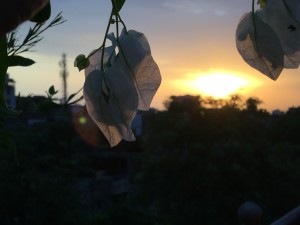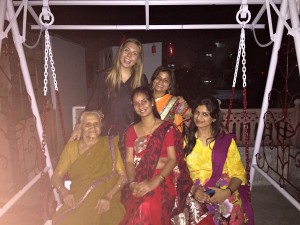Yesterday, I awoke to Venus and the crescent moon low on the horizon, just rising as 4am turned to 5 in Bapu Nagar, Jaipur. As the Earth makes its rounds, young sitarists and myself dress in either white, green or saffron dress clothes, and gather at a yoga ashram. This morning promises to be one for the books.
My host father ChandraJi has put together a powerful rendition of the Vande Mataram, a classical patriot song, featuring 80 sitar players (ChandraJi’s students, the majority of which are young women). The performance was to be the central piece of a large event called “Voice of Unity”, which was put together to support the spiritual health and union of people in Jaipur, and to encourage empowerment of women and impoverished peoples.
After one hour and thirty minutes of exerting the intense manual energy necessary to dressing in a Sari and arising to the classical standard of formal appearance, my host sister and I made our way to meet all the other performers. The yoga ashram is one block from ChandraJi’s house, where I am living. This was my first time wearing a sari, though saris are the average dress for women in many parts of India and I have been admiring the absolutely gorgeous aesthetic since I arrived. Putting on a sari is no piece of cake as I found out – I was completely helpless and cannot fathom how the sari was created. I’m very curious how/when it came into fashion…Talk about highly evolved fashion, the sari was designed by a genius of space, but certainly not time. My host sister went through many steps of folding the long silky fabric in particular ways, hanging the folds, safety-pinning them in place, and making sure the state of cultivated perfection wouldn’t falter throughout the day. Yikes one of those safety pins were to come out I really can’t imagine the outcome. Horrifying.
Anyway, I’m dressed in a completely white sari, wearing pearls from my host sister, feeling the already intense experience of having light skin become more palpable. I’m slightly on edge about performing (in front of tens of thousands of Indians) an Indian patriot ballad. Why am I part of this? What is the impact of my presence as a westerner? I was beginning to feel very uncomfortable. My friend Judy, who is studying with American Institute of Indian Studies in Jaipur and takes sitar lessons from ChandraJi, is from China and was also incorporated into this performance. Judy is from China but studies in the United States. She was placed next to me in the performance order. Its always interesting to note how being with another “other” shifts the dynamic of interaction between yourself and the culture you’re interacting with. Together we shared the experience of feeling slightly out of place, and for me this always heightens the tension of awareness of being different.

Organizing 80 bubbling young folk is never easy. We met at the yoga ashram because it’s the only space big enough for this many people and sitars to meet. After we were organized and given seating positions, we clamored onto a few buses. Again, jam packing sitars and human bodies in any space is a challenge, much less a space moving through central city traffic…Luckily the event location was quite close.
When we arrived, we climbed onto risers, which stood in front of what appeared to be an endless street filled with empty gates. In the distance, probably a quarter of a mile away from the stage, I could make out a churning sea of heads. There were people, what looked like sea of many, many people way behind the gated area. The people who were to be in the gated area weren’t there yet, I guessed. It was around 8am and the event was to start at 9. I really had no clue what to expect, all I knew was that everyone around me had been practicing this song for the past two weeks and there would be admired people speaking. I was told that there would be one million people in attendance.
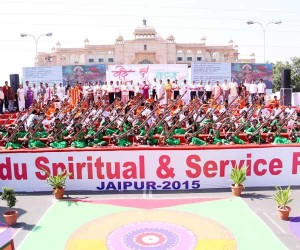
The sun started to sing and I remembered how long my day had already been. Every day, the sun tells quite the story here in Jaipur. As the Earth spins in the morning, frosty pink, salmon, peach deep hues of light swim across the horizon and the temperature is generally quite lovely (80s). Usually there’s a nice breeze, and no mosquitos yet. There’s a good 4 hours of purely enjoyable climate. Then, between 8-930 the cool duskiness of light crescendos into full-fledged flamboyance. Sometimes I swear I’m feeling solar flares – the heat feels like its radiating from just inches away. On the risers, I really felt that switch flip and convection bake settle into the air. It was rough.
To my astonishment, by 9 people had nearly filled the gated parts right in front of the stage. Generally, time is a loose concept in Jaipur and I was expecting the event to begin much later than expected. My friend sitting behind me informed me that more than 60 schools (middle schools/highschools) would be attending, and the event was kind of like a school assembly. Young children wearing uniforms filed in and took a seat in the blistering heat on green carpet which covered the asphalt street. I really could not comprehend how many people were there. I don’t think I’ve ever been in the organized presence of so many humans before, and especially not sitting in front, feeling the attentive energy of that many minds.
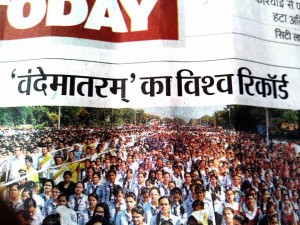
A guitarist, flautist, and percussion player kicked off the event with a rockin’ tune that got everyone cheering and dancing. After their first song, the army of sitars ignited in a fast rag that didn’t get as much outward crowd participation but I like to think the audience was mentally participating to the fullest extent possible. Sitar is nothing less than an enlightening instrument in all respects, and 80 sitars projecting sonic enlightenment is like an incubator of peace.
I really enjoyed that this music was able to bring peace to an otherwise hectic and overwhelming experience. Large urban settings are always jostling for the concentrated mind, and it was very unique to see this space transformed so radically for a few moments.
The MCs would speak into the microphones “Bharat hai, Bharat hai, Bharat hai!!!!” which was like a battle cry causing every mouth to open and yell “HAIHAI!” The event began to feel less like a spiritual support gathering and more like a nationalistic rally. Honestly I felt conflicted the entire time. Photographers were coming up to me and taking my photo throughout the entire performance. I did not feel comfortable being the subject captured in photos meant to represent this event – what a strange presence to have.
I’ve continuously interacted with this exchange of presence while in India in all kinds of situations. This event made this repeated dynamic extremely tangible. My host father insisted my presence would be important and add to the program and was very proud of bringing his two international students to perform. I suppose I’m just uncomfortable with the inauthenticity of what my presence adds to a situation and wish not to receive praise and attention, especially for the fact that I was born into a westerners’ body.
After we finished our third song, the groovy flute/guitar/drum band played other very famous patriotic music, which got the entire crowd on their feet (despite the apparent heat exhaustion) and singing. The songs were Hindu chants that I recognized from kirtan gatherings I went to this summer in Oregon. Hindu nationalism is a powerful mechanism in India. Whenever I’m put in a position that is slightly uncomfortable, I find the best remedy is to just go with the flow. So, I flowed, and followed the lead of my sitar friends. I cherish all opportunities to have fun being kind of a goon to good music, so this was really easy. Luckily, the journalists were right there to capture my exuberant participation in singing these songs. The photo made the newspaper the next day.
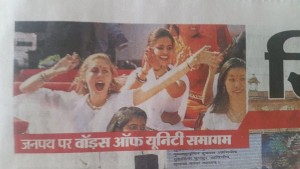
I’m still considering why the westerner is highlighted in the coverage of this India nationalist event. As I mentioned above, I know that the influence of a westerner present at a nationalist rally maybe interpreted as the voice of western world empowering the voice of India, which is cool, but I’m not comfortable being the voice of the western world. In fact I’m not even comfortable identifying as a United States citizen. I think recognizing the underlying unity our human voice is important, but to contribute explicitly to this point would have been authentically empowering, rather than my skin being my assumed vehicle for communication. If the western presence is valued so much, it can’t be at such face value. Anyone could have been up there with light skin and had no thoughts or see no value in unity, yet been labeled this great symbol of empowerment. Imperialism of sorts?
The Chair Minister of Rajasthan came up to the top riser after we played 3 songs and spoke about the empowerment of India as a nation. On her way back down the risers, she stopped and asked me where I’m from and what I’m doing here. Again, the attention based on my appearance was just unsettling. People were eager to catch her eye and show their respect, and I was zoning out thinking about the coconut that was presented to us earlier when she pulled me out of my dream state and addressed me before all these people.

This experience was such a gift. I am thankful to have so intimately touched a public event like this. I’ll never forget it.
This was another photo that appeared in another newspaper today. The journalists really captured two sides of this Western presence at an Indian event. I’m curious why each chose the photo they did.
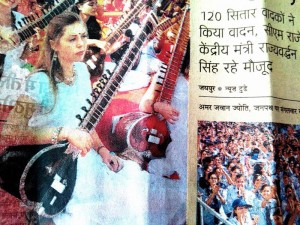
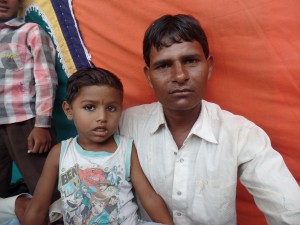 What is my push/pull motivation to be in India? Am I comfortable with my current awareness of being a social justice tourist, hopping around like a bunny surveying different scenes without getting blood on my hands, extracting little snippets of life to add to a collage referred to as a “worldly perspective”?
What is my push/pull motivation to be in India? Am I comfortable with my current awareness of being a social justice tourist, hopping around like a bunny surveying different scenes without getting blood on my hands, extracting little snippets of life to add to a collage referred to as a “worldly perspective”?







